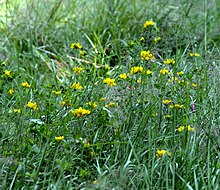Marsh horn clover
| Marsh horn clover | ||||||||||||
|---|---|---|---|---|---|---|---|---|---|---|---|---|

Marsh horn clover ( Lotus pedunculatus ) |
||||||||||||
| Systematics | ||||||||||||
|
||||||||||||
| Scientific name | ||||||||||||
| Lotus pedunculatus | ||||||||||||
| Cav. |
The Lotus pedunculatus ( Lotus pedunculatus ) is a plant of the genus foot trefoil ( Lotus ) within the family of the Leguminosae (Fabaceae).
description
Vegetative characteristics
The swamp horn clover is a perennial herbaceous plant . The upright to ascending, mostly bald stems are hollow and 20 to 90 centimeters long. Subterranean runners are formed.
The alternate arranged on the stem leaves are sessile. The three-fingered leaf blades consist of entire- edged leaflets that are broadly lanceolate to obovate and on the underside of which the lateral nerves are clearly recognizable. There are two stipules per leaf , resembling the leaflets, and this makes it appear as if there are five leaflets.
Generative characteristics
The flowering time is in June and July. There is an inflorescence stem. The umbellate inflorescence contains five to twelve flowers.
The hermaphrodite flowers are zygomorphic and five-fold with a double flower envelope . The cup is at a length of 6 to 7 millimeters of half the length of the crown. The five identical, mostly long calyx teeth are bent outward at the buds, and between the two upper calyx teeth there is a pointed bay. The yellow crown has the typical shape of the butterfly flower and is 10 to 14 millimeters long. The petals are long nailed. The shuttle is curved upwards, beaked and the upper end is light. The ten stamens are all fused together to form a tube except for the upper one.
The glabrous legume is straight, 1.5 to 3 inches long and contains numerous seeds.
The number of chromosomes is 2n = 12.
ecology
The swamp horn clover is a mesomorphic, helomorphic hemicryptophyte .
The pollination is done by insects .
Occurrence
The swamp horn clover is widespread in Europe and North Africa. As a neophyte it is also found in Australasia , Oceania and North and South America.
The swamp horn clover usually thrives in partially shaded locations on relatively nutrient-poor, weakly acidic to moderately basic soils . In Central Europe it is a character species of the Calthion association, also occurs in the Juncion acutiflori association, the Molinion association and in moist arrhenatheretes.
Taxonomy
The first release of Lotus pedunculatus was made in 1793 by the Spanish naturalist Antonio José Cavanilles in Icones et Descriptiones Plantarum , 2, page 52, Table 164. synonyms for Lotus pedunculatus Cav. are Lotus granadensis Zertova and Lotus uliginosus Schkuhr . The specific epithet pedunculatus means "with a stalked flower".
proof
- Lotus pedunculatus Cav., Marsh Horn Clover. In: FloraWeb.de.
- Erich Götz: Identify plants with the computer. 2001, ISBN 3-8252-8168-X .
- Karl Reiche: Flora of Chile. Volume 2, p. 76, PDF (PDF; 315 kB).
Individual evidence
- ↑ a b c d e f g h i j Lotus pedunculatus Cav., Swamp Horn Clover. In: FloraWeb.de.
- ↑ a b c d e Lotus pedunculatus Cav. In: Info Flora , the national data and information center for Swiss flora . Retrieved November 18, 2015.
- ↑ Lotus pedunculatus at Tropicos.org. In: IPCN Chromosome Reports . Missouri Botanical Garden, St. Louis
- ↑ a b Data sheet at International Legume Database Information Service = ILDIS - LegumeWeb - World Database of Legumes , Version 10.38 from July 20, 2010.
- ^ Erich Oberdorfer : Plant-sociological excursion flora for Germany and neighboring areas. 8th edition. Verlag Eugen Ulmer, Stuttgart 2001, ISBN 3-8001-3131-5 . Page 599.
- ↑ Lotus pedunculatus at Tropicos.org. Missouri Botanical Garden, St. Louis, accessed October 31, 2018.
Web links
- Marsh horn clover . In: BiolFlor, the database of biological-ecological characteristics of the flora of Germany.
- Profile and distribution map for Bavaria . In: Botanical Information Hub of Bavaria .
- Distribution in the northern hemisphere according to Eric Hultén
- Thomas Meyer: Data sheet with identification key and photos at Flora-de: Flora von Deutschland (old name of the website: Flowers in Swabia ).
- Gerhard Nitter: Profile with photos.
- Günther Blaich: data sheet with photos.

